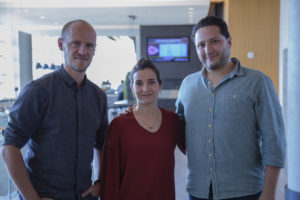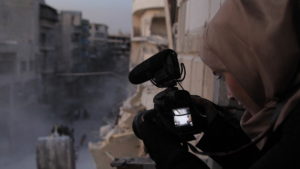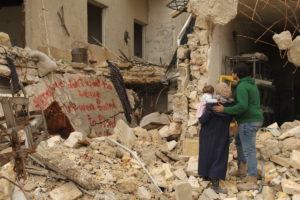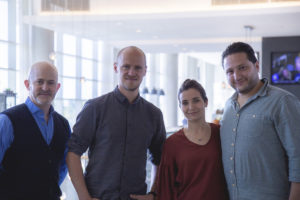Interview with “For Sama” Directors Waad al-Kateab and Edward Watts, Plus Hamza al-Kateab
Written by: Christopher Llewellyn Reed | November 19th, 2019

After a brief theatrical run, the new documentary For Sama (which I recently reviewed) receives its broadcast premiere today (November 19, 2019) on PBS’ Frontline. The film tells the story of how Waad al-Kateab and her husband Hamza, a doctor, lived through the current Syrian civil war, beginning as hostilities break out and then continuing to their escape to England. Dedicated to Sama, their first-born daughter (they have since had a second girl, Taima, as well), the movie mixes bleak chronicles of atrocities with a moving first-person video essay. As much of a nightmare as the situation may be, the film is also profoundly life-affirming. At the end of October, I had a chance to sit down in Washington, DC, with Waad and her co-director, Edward Watts (Escaping ISIS), as well as Hamza, for a brief conversation. What follows is a condensed digest of that interview, edited for length and clarity.

Christopher Llewellyn Reed: Waad and Edward, how did you two meet and decide to collaborate?
Waad al-Kateab: I was shooting for five years in Aleppo, since 2011, when the revolution started, through 2016 when displaced out. So, when I left Aleppo, I went to London for the first time in 2017. I had 12 hard drives, over 500 hours of footage, but I had no idea where to start. So, at that time, I met with Edward. We’d been introduced to each other by our other colleagues at Channel 4 and Channel 4 News. And then we started sitting together, speaking about how we might make something from this material.
Edward Watts: Yeah. And that was two years ago. We worked together for two years on the film, and it was a real privilege for me because some of Waad’s material had been made available via our colleagues at Channel 4 News, so I’d been following the siege of Aleppo, I knew about her work, but I hadn’t had the chance to meet her. It was an incredible thing to meet her and see this amazing archive she’d gathered of over 500 hours over five years.
CLR: Were you similarly working for Channel 4 News?
EW: No, I’m independent. But I know a lot of those guys there and we work in similar areas of the world and yeah, they do great work.
CLR: So, how did this collaboration work, since Waad had already shot everything? Who did what in the final cut of the film?
Wa-K: When we met, we started speaking about the possibilities of the stories, like what the story is that I have. We sat for 10 days watching some of the material. And then we met again in London. We sat together, we had our editor and we started speaking about, actually more like trying to know each other more and speak about what the main things that affect our story in Aleppo, what the most difficult things were, what was the greatest happiness that we had.
Ed came into my life and went through all the material again and again. We also had a great team of translators. When I started working with Ed, my English wasn’t good enough to speak and explain a lot of things. So, most of the conversation was more like signs and trying to, as much as I couldn’t speak in English and as much as he could try to understand what I was trying to tell him. So it was really two years of great work together.
EW: Yeah, I mean it was just as Waad says: through the two years, there were different stages of the process. We had to work in different ways. Initially, these guys didn’t have asylum in Britain. So, at the beginning, it was just this process of trying to communicate with each other, be together as much as we could and pulling together between these two perspectives. You know, the most important thing was these guys had lived it and Waad, actually she filmed, I think it’s like 99 point something percent of what you see in the film is all shot by her and with only a couple of archive shots in addition.
And so, it was really trying to retain the essence and the truth of what it had been like for these guys going through it, but also trying to distill it into a form that a Western audience that maybe didn’t know anything about Syria, that was coming in off the streets of a very different world, could still engage with the story, understand what was going on and most importantly, feel it, feel the emotions, feel the story, the hope through to the horror of what these guys have been through. And that was our process of sculpting it together.

Wa-K: You need to live that story and be a part of it, not just like director or a filmmaker who’s shooting this, but also the person who lived that story and can separate myself out of this. This was part of the advantage for the film, but also was part of the disadvantage, because I need to take one step back and start thinking about the film as a film, more than my experience. At the same time, we need to make people outside, as Ed said, understand how this experience needs to be.
CLR: Sure. Because you have to shape it as a cinematic experience …
EW: Exactly.
CLR: … beyond the compelling things that are already in the film itself.
EW: I think so often when people – filmmakers – are dealing with such dramatic human experiences, such horrific human experiences, that when they have such extraordinary characters as Waad and Hamza, they can fall into the sense that audiences should automatically care about this.But I think it’s so important that we as filmmakers put the effort in to bring the audiences in, to invite them in and to hold them with us through this story, which is like an experience, it’s a real emotional experience where you laugh and you cry and you see immense pain. And I think it’s so important that we do a service and we think about our audience because otherwise, they just get numb or they can get lost in the material.
CLR: In fact, one of the questions I was going to ask later, but I’ll ask it now, was about that very problem. So, I don’t think I’m a terrible human being, but I am sometimes numbed when I watch certain films, and there have been many documentaries about Syria, because it’s so horrific what’s been happening there, and the challenge is, “How do I make this material more compelling than just showing the horrors,” right? “Here’s another dead baby,” which should be horrifying, but after a while, there’s a certain fatigue that sets in to the viewer and the challenge is shaping the material so that we get beyond that feeling. And I think you did a wonderful job.
EW: Thank you.
CLR: I mean, yes, there are some horrors that we see, as there should be, but I think you shaped it really well. How did you navigate what to show so that it did not create this fatigue for the both of you?

Wa-K: This collaboration with Ed has given me the chance to present myself and speak out in a way that you’ve seen in the footage, but also beyond that. Other directors, unfortunately, they usually doesn’t include in their consideration the people who live the story or the people who filmed it. I was so really grateful to Ed for that chance, because I was so terrified from the beginning.Because I’ve seen many other films and I’ve seen that the people who shoot it or they lived it, they are not part of this process.
EW: There were a lot of different things that we were thinking about in the storytelling. Number one was the fact of what Waad had captured in her footage, which is the whole spectrum of human life within these conflict zones and the fact that there is humor and there are moments of hope and joy even in the worst circumstances. And that was one of our real motivating factors. So, you see us in the film constantly trying to have this rhythm between yes, something horrific, but then just having a moment that counteracts that. So you’re always moving between the poles. You’re not just staying in darkness and despair because I think that’s the point where audiences eventually just get overwhelmed.
And so you know, a testament to these guys, if you look in the film deliberately when there’s a moment of horror, sometimes we’ll just go to Sama’s face, uncut, for like two minutes because that just allows people to breathe again. And the other thing was that we did think a lot about how do narrative storytelling. You know, what would a fiction film do, what are they trying to do in terms of the story beats to bring the audience in, to introduce characters, to do the arc of the story?
CLR: Well, I thought you did a great job. (to Waad and Hamza) So, let me ask you now, how is life in London for the two of you and for Sama and Taima? How have things changed for you now that you’re there?
Hamza al-Kateab: We are still in the adapting phase. First of all, processing all that we’ve been through and trying also to provide a settled environment for the kids to grow up in. Sama is now four years old and Taima is two and a half. They’re doing well, they’re going to the nursery, starting to get this weird British accent. (laughs)
CLR: (laughs) That’s right, you’re going to have British children.
Wa-K: (laughs) We almost have!
Ha-K: And we’re still just in the middle between establishing the new life that we’re now in and building our future, basically. And we’re also still connected to the ground and to the people, to what’s the situation now in Syria. So, in that position, we’re still in the middle.
CLR: Are you able to work as a doctor?
Ha-K: In theory, yes. I need to just do an exam to be qualified in the UK. But at the moment, I’m focusing on working with a company, helping to send funding to Syria. So, now I’m helping to fund around 32 hospitals that are working in Syria at the moment.
CLR: Excellent.
Wa-K: We’ve also just been focusing on the film right now … using it as a tool to keep fighting for our freedom in a different way, to stand and tell people as you watch this film, “This is still happening.”
CLR: One of the things that I found particularly interesting about this film was reading, Waad, that you had to teach yourself filmmaking, how to film as you made this movie. So what would you tell other people who similarly had a story to tell but didn’t know anything about how to shoot and how to handle the camera? What would you say are the important things to think about?
Wa-K: The main thing is don’t stop and don’t give up and say everything you want to say. Just try to record everything you can in any way you feel and just follow your feeling, follow the things that you feel that, “This is really important to me,” or, “This really explains my situation.” And really, I hope that the film will give some inspiration to other women to tell their stories and other mothers to feel that motherhood, which is challenging, which we all feel, is not something that will stop us, but its opposite exactly. It can encourage us to tell our stories in different ways, and I hope people and women, especially, can take that from the film.
CLR: Well, thank you so much for making the film. I really enjoyed it.
All: Thank you very much!


